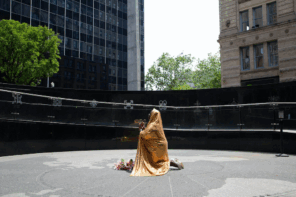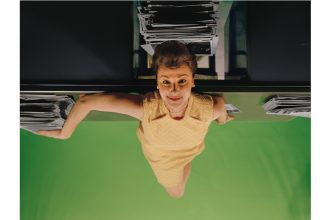Walking the AGO’s latest exhibition Picturing the Americas: Landscapes from Tierra del Fuego to the Arctic with Wanda Nanibush, an Anishnawbe-kwe artist, consultant, and curator, is an exercise in critical resistance. She gestures to the 118 landscape paintings that line the gallery walls, and asks, “are there paintings we just shouldn’t show anymore?”, answering her own question. “There are things we don’t need to repeat.”
Nanibush is performing the role of an ongoing consultant to the AGO (her official title is Content Researcher and Programming Advisor), helping to better position Indigenous, Aboriginal, and First Nations artists within the permanent collection, and curating exhibitions for the museum’s roving program.
She traces her finger over a painting label that orients the viewer to its landscape within the Americas. “I thought they were going to mark what Indigenous place this was on the map,” she says. “That would have been a way of disrupting the narrative. Someone told me they were going to do that.”
We approach an alcove where a film isn’t working. Mark Lewis was chosen for the singular contemporary-art intervention within this historical exhibition. Nanibush regards this as a missed opportunity, preferring that an Indigenous artist be selected for this unique spot. She walks past it, saying, “We were going to do alternative tours of the show but I don’t think we’re going to, anymore. It’s too difficult to speak within someone else’s vision.”
Despite this, Nanibush treats me to an editorializing tour of Picturing the Americas, though maintaining her focus on the event we’re here to discuss, one that will, on July 2nd, form a strong rebuttal to this exhibition from within the museum’s walls.
Guest-curated by Ombaasin, the Indigenous artist collective comprised of Nanibush, Elwood Jimmy, and Brian Norton, “Land Rights Now” will be the last AGO First Thursday event of the season, and certainly the year’s most political. The program features “artists of color and Indigenous artists calling attention to the complex meanings and histories depicted in Picturing the Americas,” a list that includes Lori Blondeau, Adrian Stimson, Francisco-Fernando Granados, and the Polaris Prize-winning Inuk throat singer Tanya Tagaq, among others. Nanibush discusses this event as an intervention and a rebuttal to the new exhibition. She considers it a frame she’s working to re-establish, with different terms.
You were just saying something important before we began this interview, that “this could have been anything.” This show, which traverses Brazil, the US, and Canada, could have taken any number of forms. You say you’re not sure an exhibition of colonial landscape painting is, at this point, “required.”
[Laughs] I know, it’s such a harsh thing to say. But, yes, for us, anyway. I think they’ve tried to incorporate Indigenous voices into the show. You’ll see them around the corner, and talking about the treaty in Toronto. That’s one way that they’ve tried to keep it in people’s minds that “landscape” erases the Indigenous inhabitants, erases an entire colonial history, just in the mere painting of them.For us, I felt like we curated a program, “Land Rights Now,” that’s a direct response to the landscape show. But yeah, they could have included contemporary Indigenous art, here; it wouldn’t have hurt anyone. It’s a very old-school, historical show.
How did the opportunity to curate this event arise?
Sean O’Neill [manager of AGO First Thursdays programs] approached us. And I thought I’d rather do it with a collective than inside the institution; get a little more freedom. They already had wanted Tanya Tagaq to play, and I thought her Nanook of the North performance would be really great, ’cause that’s also a text of landscape where Native people are an aspect of the landscape, as if they were as natural as the landscape. As if they constructed the world that the Inuit were living in. She does a performance with it and her performances have become so fierce. I thought it was a good intervention into the idea of landscape or “us as landscape,” a second stage.
Can you parse that a bit, the “us as landscape” idea?
Well it’s the idea that land itself, when settlers arrived here, was natural, untouched. And if Native people are on that land – which they aren’t, here, anywhere [scanning the exhibition] – they’re just part of the land, part of nature. They’re not an industrious thing. This is the distinction between civilization and savagery, that [we] are more natural, [we] blend into our environment, are one with the land. But if you look at the history of the Americas, even in terms of land, prior to 1492, it’s thought that we developed the prairies through constant yearly burnings, we developed pine-grow forests, agricultural lands. The land was definitely intervened upon by Indigenous people. So it disrupts this idea of “nature.” Intervention has always been there.
[Gesturing to a video in which Hayden King is speaking, an Anishinaabe writer, and director of the Centre for Indigenous Governance & Assistant Professor of Politics at Ryerson] What do you make of this kind of critique being positioned within the institution, within the curatorial context, when the curating doesn’t seem to have anticipated this criticism, and responded in advance of it? What do you make of that strategy?
I think it’s not a great strategy! [Laughs] But I think the AGO is actually much further along than this [exhibition]. If you go through the Canadian galleries, the way they’ve been curating their recent shows, this is actually a step back. So I think they did what they could, including voices, but there’s more that they could have done. But then it would have been a different show; and you can’t really fault a show in that way.
When you took the invitation to “respond,” was the idea that you’d be responding directly to this exhibition, or did you simply want to produce an event that had something in common with it?
I think it’s a direct rebuttal, rather than a conversation. When you say “Land Rights Now” in response to a landscape show, I think it’s very clear. So I’m not going to go through and say, “Oh, how could we think of Krieghoff?”, because that still uses this as the standard for the conversation. So we just start a different conversation. Change the frame entirely. In that way it responds, but it’s more of an intervention than a conversation.
How affective is interventionist curating? Or strategies that, in this case, last the length of an event? How affective can these be? How aspirational is it that one can parachute into an event and make commentaries from within it or around it, and abandon site? Do you worry that this will be too nuanced for a First Thursday party’s reception?
I don’t think so. There are a lot of aspects that people won’t get, for sure. But there are enough opportunities for an experience that you may not understand at the moment [but comprehend later]. You’ll receive words, texts; you’re walking away with tokens and icons that you can contemplate later. We’re also working to get a shitload of Indigenous people under the roof here, because that doesn’t happen. We [the AGO] got a lot of new members just through the Anishinaabe show. I think there’s opportunities for that, for people to feel welcome here, and to create a kind of presence.
And the Canadian galleries have been changed. So when you walk into the first space, you have Nadia Myre’s piece, Rethinking Anthem, which is being erased over and over again, and then there will be Shelley Niro’s The Shirt, which is very much about land, women’s bodies, and colonization (and it’s also very humorous). On the other side there’s Carl Beam’s Burying the Ruler, talking about Western thinking in general and residential schools in particular. Daphne Odjig’s work on the family, and then Christi Belcourt’s piece on the Indigenous plants that have gone extinct.
So that narrative is here, such that if they come back, they have ways of engaging in these conversations for longer with these permanent collection shows.
This re-hang of the permanent collection show, to incorporate and forefront more Indigenous voices: is this your effort?
It’s partly my effort; largely it’s Andrew Hunter [the AGO’s Fredrik S. Eaton Curator, Canadian Art]. That’s his desire for that space.
With the Truth and Reconciliation Commission, in addition to so much else, there are myriad exhibitions being erected across Canada, now and imminently, featuring Indigenous, Aboriginal, and First Nations artists. How are you reflecting on this moment? Are you frustrated that it’s required a belated political spotlight for our cultural community to respond in kind?
I don’t know, I do a lot of work on residential schools, and I do a lot of work in relation to thinking through trauma and its relationship to art. I’ve been really – in writing, publications – critical of the Truth and Reconciliation Commission. But Andrew [Hunter] and I were talking about this the other day. I said, you’re already implementing some of the recommendations in your programing. The AGO should put that front and center. The AGO could be a leader in helping other organizations figure out how they might develop some kind of policy around the nation-to-nation relationship, around reconciliation, around implementing recommendations. I think, in that sense, it would be great if an organization started thinking that way. And thinking about their institution as [existing] on Indigenous land. I wish that people, instead on adding-on or including, [used] an entirely different frame of mind as a starting place. It’s like when you start [an exhibition] thinking about nation-to-nation relations, about colonialism, about the place of Indigenous people, at the very beginning, then the shows never end up a certain way. As I say, there are things we don’t need to repeat.
























1 Comment